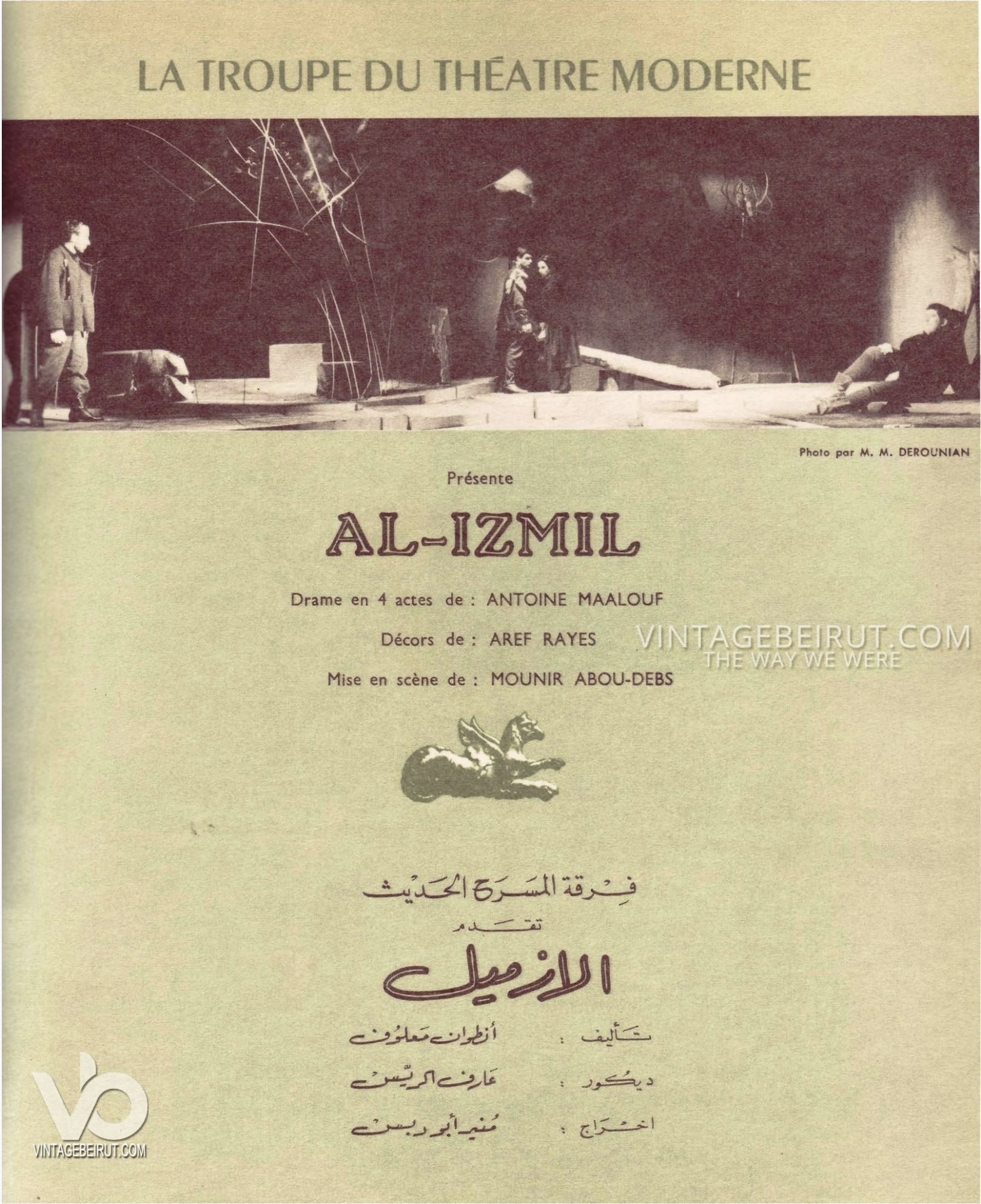During its heydays in the 1960s, Beirut was buzzing with theatre-makers and theatrical experimentation. In those years, directors collaborated with burgeoning artists-set designers to enhance the quality of their theatrical production. Director Mounir Abou Debs (1932-2018), the co-founder of the first school of theater and the Modern Theater Group in Lebanon, collaborated with Aref Rayess, the artist he befriended in Paris. As a progressive and imaginative artist, Aref Rayess created the set design of one of Abou Debs’s early plays, al-Izmil (The Chisel). The play was written in eloquent classical Arabic by Lebanese playwright, Antoine Maalouf. It was first staged at the West Hall in AUB and then at the Bacchus temples of Baalbek in 1964.
Aref Rayess (1928- 2005) was a Lebanese multidisciplinary artist. Besides being a successful painter and sculptor, he ventured into dancing, acting, and set design. The first role Rayess assumed on stage was in al-Muhajir (The Migrant), in 1955, directed by renowned Lebanese actor Adib Haddad. Also, Rayess took part in Mounir Abou Debs's play Hannibal and performed in the ballet theatre La Belle au Bois Dormant ( The Sleeping Beauty). In Paris, he trained with cubist artists Fernand Léger and André Lhoté. While studying at the Académie de la Grande Chaumière in Montmartre, in 1948, Rayess learned the art of corporeal mime under the tutelage of Étienne Decroux and Marcel Marceau and trained in sculpture with Ossip Zadkine. He continued to sharpen his sculpting skills in 1957 under the mentorship of Antonio Berti, in Florence, then under Lionello Vantouri and Alberto Giacometti in Rome, in the early 1960s. During this time, his work took on an expressionistic style manifested in his artworks and in al-Izmil ‘s scenic design.

A theatrical melodrama, al-Izmil is a story of love, sex, death, and mercy, ruled by the unconscious. The play revolves around emotional competition and the Oedipus complex. It voices the story of a gentleman named Damon (played by actor Antoine Kerbej) who is torn between the love of his mother (played by Rida Khoury) and his wife, Nardine, (played by Rene Deek). Damon, who is obviously under the spell of his possessive mother, leaves Nardine feeling undermined. As such, Nardine reaches for solace and affection in the arms of Zad, Damon’s gardener (played by Michel Naba’a). Having discovered his wife's adultery, Damon imprisons her and the gardener in a cave. Nardine, who is overtaken with fear and insecurity, tries once again to seduce Zad, hoping that he grants her protection. But, Zad, who is too busy carving a statue with his ‘chisel,' offers her no attention. In his imprisonment, Zad recalls his deceased mother and prays to 'Hadad’ – the God of hurricanes, storms, thunder, and rain.

In a setting impregnated with emotional tension, elated by Narciso Yapes's music, the scenic design created by Rayess played a significant role in the play's success. Rayess adopted an expressionist symbolic approach to his creation. For instance, instead of building a seemingly natural cave, where Nardine and Zad were to be imprisoned, he created a suspended metallic web in a spider's shape, as a visual metaphor. The structure, occupying much of the stage's space, formed a suffocating low ceiling resembling an underworld against a background of tree trunks, rocks, and statues. Rayess also introduced planar divisions into the space by using contrasting materials such as silk-fabric partitions next to the sharp metallic structure. The overall setting was gloomy and dark, yet interrupted with intentional light spots highlighting the actors' bodily gestures and facial expressions. In this all, Rayess reflected the multiple dichotomies expressed in the play.
In his words, Rayess expressed, “I worked with the space like a moving sculpture; and dealt with elements such as visual composition, mass and volume.” He added, “the suspended metallic strings were meant to abridge the audience and the actors.” His set design, light, sceneries, costumes, and the actors' corporeal movements merged into a seamless whole - the mise en scène.
Sources
Saiid, Khalida. Al-Haraka-Al-Massrahiya-Fi-Libnan. Baalbek Festivals Committee. Arayia, Baabda: Catholic Publishers, 1998.
Saeed, Ahmoud. “Khalida Said Documents Golden Period of Lebanese Theater.” Khalida Said Documents Golden Period of Lebanese Theater | Al Jadid. Accessed September 7, 2020. https://www.aljadid.com/content/khalida-said-documents-golden-period-lebanese-theater.
“Composers & Librettists.” Opera Lebanon. Accessed September 11, 2020. https://operalebanon.org/compo...
RAYESS - Artists.” Dalloul Art Foundation. Accessed September 11, 2020. https://dafbeirut.org/en/aref-rayess.



Comments on Aref Rayess Sculptor of Space: al-Izmil